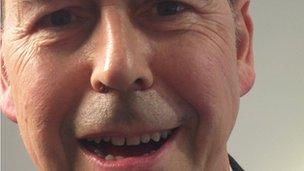Nokia’s Symbian surprise
- Published
- comments
Rory Cellan-Jones takes a look at the Nokia 808 Pureview
Last year Nokia's Stephen Elop flung his company off what he described as a burning platform, putting the Finnish giant's Symbian operating system out to grass to get into bed with Microsoft's Windows Phone. But on Monday morning he appeared to leap straight back on the platform.
The new Nokia 808 PureView seems to be an astonishing beast, a cameraphone with a 41 megapixel lens. We know that more megapixels do not mean a lot if the technology behind it - notably the sensor - isn't up to much. But Nokia has been showing off images shot on the phone blown up to poster size, and they look pretty good. What's more, it shoots in full 1080p HD video, so with one of these rather hefty handsets in your pocket, you should have everything you need to shoot quality images on the move.
But just a moment. The 808 is a Symbian handset, and with a hefty price tag is not aimed at the developing world. With Symbian's share of the smartphone market plummeting by the day - it had dipped below 12% last time I looked - and all of Nokia's marketing efforts aimed at its range of Lumia Windows phones, the 808 won't be at the top of many people's shopping lists.
In fact, the phone - for all its high-end technology - feels like a solidly made Nokia from about five years ago. Back then it would have sold by the million. Now the world has moved on and smartphone photography is all about apps, which won't be developed for the Symbian platform.

The "uncomfortably close" photo of Rory
When I met Elop here in Barcelona at the Mobile World Congress, he immediately whipped out the PureView phone, took a picture of me, and zoomed in uncomfortably close to show how much detail the phone could record in an image.
When I asked why it was on Symbian, not Windows Phone, I got no very satisfactory answer, except that the team behind the technology had been working on it for five years, and it would come to the Lumia range later.
We quickly moved on to discuss what progress had been made since last autumn's launch of the Nokia Windows phones. He was keen to tell me that the first Lumia handset in the United States was "exceeding expectations". Without detailed figures it's hard to know whether Nokia is making any headway from a standing start in persuading consumers that there's more to smartphones than Apple or Android.

Stephen Elop with a photo taken on the new phone
But in the UK a good source tells me, for all the expensive marketing which accompanied the launch of the Lumia 800, Nokia managed to sell 10,000 a week compared with 130,000 for Apple's iPhone 4S.
Elop remains confident - and quite convincing - in his belief that there is room in the market for a third "ecosystem" to rival Apple and Android's integrated worlds.
That makes it all the harder to understand why the most eye-catching Nokia announcement in Barcelona is about a Symbian phone.
But maybe it's a move driven by sentiment - after all, it was engineers building on the Symbian platform who made Nokia a hugely powerful force in smartphones until the iPhone came along. Many of them are now leaving the business. Perhaps the TrueView is an acknowledgement of everything they contributed over the years when the Finnish firm was on top.